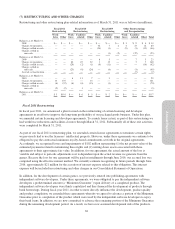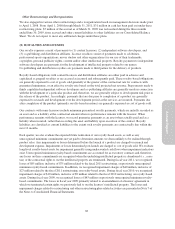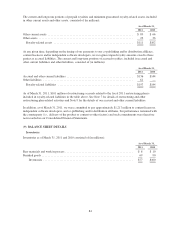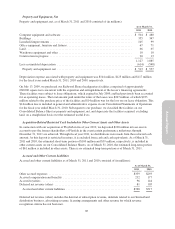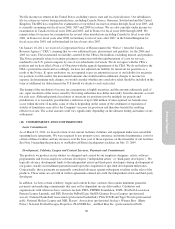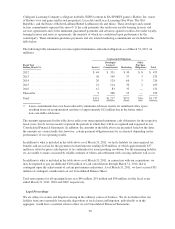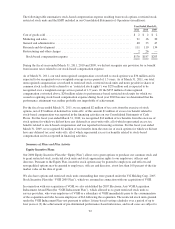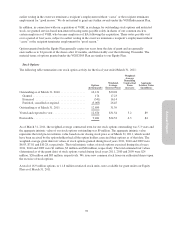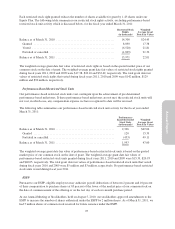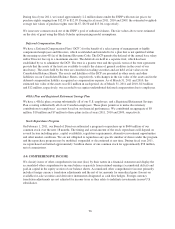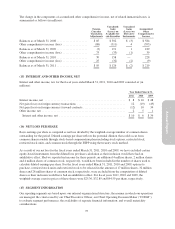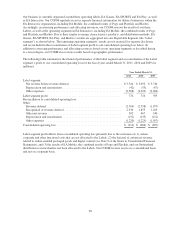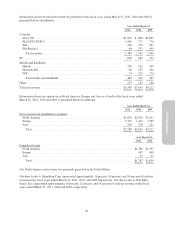Electronic Arts 2011 Annual Report Download - page 167
Download and view the complete annual report
Please find page 167 of the 2011 Electronic Arts annual report below. You can navigate through the pages in the report by either clicking on the pages listed below, or by using the keyword search tool below to find specific information within the annual report.
Annual Report
(12) PREFERRED STOCK
As of March 31, 2011 and 2010, we had 10,000,000 shares of preferred stock authorized but unissued. The rights,
preferences, and restrictions of the preferred stock may be designated by our Board of Directors without further
action by our stockholders.
(13) STOCK-BASED COMPENSATION AND EMPLOYEE BENEFIT PLANS
Valuation Assumptions
We are required to estimate the fair value of share-based payment awards on the date of grant. We recognize
compensation costs for stock-based payment awards to employees based on the grant-date fair value using a
straight-line approach over the service period for which such awards are expected to vest. The fair value of
restricted stock units and restricted stock is determined based on the quoted market price of our common stock on
the date of grant. The fair value of stock options and stock purchase rights granted pursuant to our equity
incentive plans and our 2000 Employee Stock Purchase Plan (“ESPP”), respectively, is determined using the
Black-Scholes valuation model. The fair value of our stock options is based on the multiple-award valuation
method. The determination of the fair value of stock options and ESPP is affected by our stock price, as well as
assumptions regarding subjective and complex variables such as expected employee exercise behavior and our
expected stock price volatility over the expected term of the award. Generally, our assumptions are based on
historical information and judgment is required to determine if historical trends may be indicators of future
outcomes. The key assumptions for the Black-Scholes valuation calculation are:
•Risk-free interest rate. The risk-free interest rate is based on U.S. Treasury yields in effect at the time of
grant for the expected term of the option.
•Expected volatility. For our expected volatility assumption we use a combination of historical stock price
volatility and implied volatility based on the price of options publicly traded on our common stock.
•Expected term. The expected term represents the weighted-average period the stock options are expected
to remain outstanding. The expected term is determined based on historical exercise behavior, post-
vesting termination patterns, options outstanding and future expected exercise behavior.
•Expected dividends.
The estimated assumptions used in the Black-Scholes valuation model to value our stock option grants and ESPP
were as follows:
Stock Option Grants ESPP
Year Ended March 31, Year Ended March 31,
2011 2010 2009 2011 2010 2009
Risk-free interest rate ....... 0.3-2.6% 1.4 - 3.1% 1.0 - 3.8% 0.2 - 0.3% 0.2 - 0.4% 0.5 - 2.1%
Expected volatility ......... 39-45% 40-48% 32-53% 34-38% 35-57% 35-75%
Weighted-average volatility . . 42% 45% 42% 36% 39% 66%
Expected term ............. 4.2years 4.2 years 4.3 years 6-12 months 6-12 months 6-12 months
Expected dividends ......... None None None None None None
Stock-Based Compensation Expense
Employee stock-based compensation expense recognized during the fiscal years ended March 31, 2011, 2010 and
2009 was calculated based on awards ultimately expected to vest and has been reduced for estimated forfeitures.
In subsequent periods, if actual forfeitures differ from those estimates, an adjustment to stock-based
compensation expense will be recognized at that time.
91


